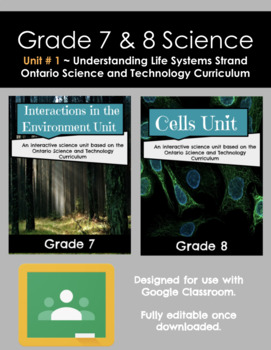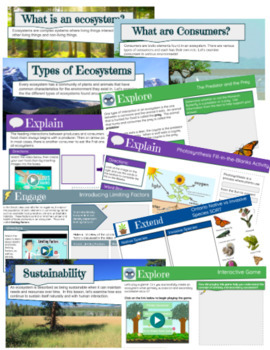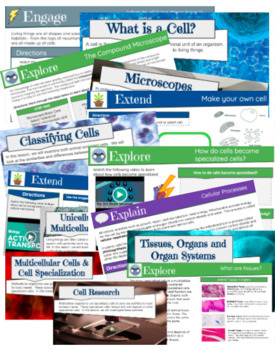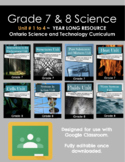Grade 7 & 8 Science Unit Bundle (STRAND 1 - Understanding Life Systems)
- Zip
- Internet Activities
What educators are saying
Products in this Bundle (2)
Also included in
- In this bundle, I have added all four Grade 7 Science and Technology Units. These lessons were made as a resource for my students "learning from home". Each lesson is was created with Ontario Science and Technology curriculum in mind.Unit 1 ~ Interactions in the Ecosystem (Nine Interactive Lessons)LPrice $93.60Original Price $104.00Save $10.40
Description
In this bundle, I have added the Grade 7 Interactions in the Environment Unit and Grade 8 Cells Units.
These lessons were made as a resource for my students "learning from home". Each lesson is was created with Ontario Science and Technology curriculum in mind.
Bundle Overview:
Grade 7 - Interactions in the Environment Unit
This product was designed for Grade 7 students to "Learn-at-Home". There are nine interactive lessons that allow students to engage in the topic, explore key scientific concepts, explain their thinking based on information learned, and extend their knowledge base. Students can work at their own pace throughout each lesson.
These lessons are aligned with the Ontario Science and Technology Curriculum. Once you have purchased this product, you will have access to each of the nine lessons.
Lesson Overviews:
Lesson 1 - What is an Ecosystem?
Ecosystems are complex systems where living things interact with other living things and non-living things. Let’s learn all about it in this lesson!
Lesson 2 - What are producers?
Producers are essential biotic elements of an ecosystem. Let’s examine their role in these environments!
Lesson 3 - What are consumers?
Consumers are biotic elements found in an ecosystem. There are various types of consumers and each has their own role. Let’s examine consumers in various environments!
Lesson 4 - Types of Ecosystems Around the World
Every ecosystem has a community of plants and animals that have common characteristics for the environment they exist in. Let’s examine the different types of ecosystems found around the world!
Lesson 5 - Energy Transfers
Some of the light and heat that flows from the Sun is absorbed by producers. Through photosynthesis, the producers change that energy into sugars that they use for foods. Consumers then eat the producers, therefore transferring this energy to other organisms. Let’s examine this process!
Lesson 6 - Why do ecosystems change?
Ecosystems are constantly changing and adapting to the world that we live in today. Let’s examine how these changes affect the environment big and small.
Lesson 7 - Sustainability
An ecosystem is described as being sustainable when it can maintain a balance of needs and resources over time. In this lesson, let’s examine how ecosystems continue to sustain itself naturally and with human interaction.
Lesson 8 - Succession, Recovery, and Renewal
What happens when an environment suddenly changes due to natural disasters or human intervention? Can the ecosystem recover and renew itself? Let’s examine the roles or succession, recovery, and renewal as it relates to these changes.
Lesson 9 - Assessing Human Impact
Human communities benefit from technology. Inventions and human-engineered materials have improved our survival and quality of life, however, they also affect local ecosystems. Many of these technologies have damaged ecosystems shared by all. Let’s examine how we can make changes to help reduce our impact!
Grade 8 - Cells Unit
This product was designed for Grade 8 students to "Learn-at-Home". There are eight interactive lessons that allow students to engage in the topic, explore key scientific concepts, explain their thinking based on information learned, and extend their knowledge base. Students can work at their own pace throughout each lesson.
These lessons are aligned with the Ontario Science and Technology Curriculum. Once you have purchased this product, you will have access to each of the eight lessons.
Lesson Overview:
Lesson 1 ~ What is a Cell?
A cell is the smallest structural and functional unit of an organism. Let’s examine why cells are so important to living things.
Lesson 2 ~ Microscopes
In order to study cells, scientists needed to be able to see them clearly. Let’s take a look at how microscopes work.
Lesson 3 ~ Classifying Cells
In this lesson, we will examine both animal and plant cells. We will look at the similarities and differences between these two cells.
Lesson 4 ~ Flow of Materials into and out of the Cell
In this lesson, we will examine how the cell membrane can control the flow of materials into and out of the cell using passive and active transport.
Lesson 5 ~ Exploring Unicellular and Multicellular Cells
Living things are often called organisms. Organisms are a living system with parts that work together to carry out the processes of life. In this lesson, we will examine both unicellular and multicellular organisms.
Lesson 6 ~ Multicellular Organisms and Cell Specialization
Multicellular organisms use specialized cells to carry out activities to meet their basic needs. These specialized cells interact with and depend on other specialized cells. In this lesson, we will investigate these activities.
Lesson 7 ~ Tissues, Organs, and Organ Systems
Multicellular organisms use specialized cells to carry out activities to meet its basic needs. These specialized cells interact with and depend on other specialized cells. In this lesson, we will investigate these activities.
Lesson 8 ~ Cell Research
Advances in our knowledge of cell biology have had a large impact in multicellular organisms. Let’s take a look at how scientists and researchers have made changes to cells.





